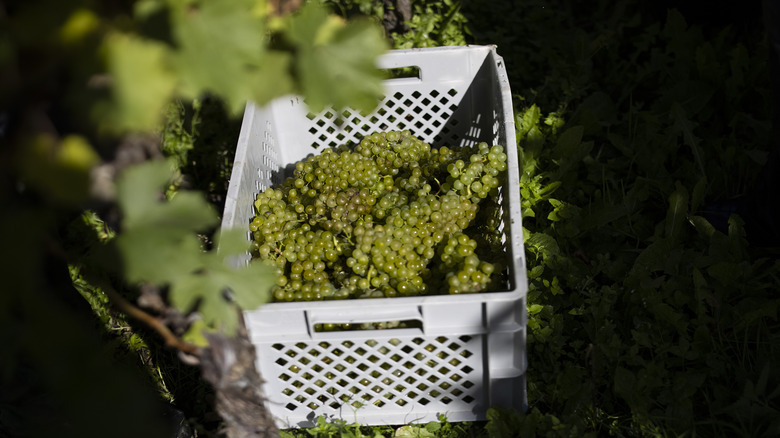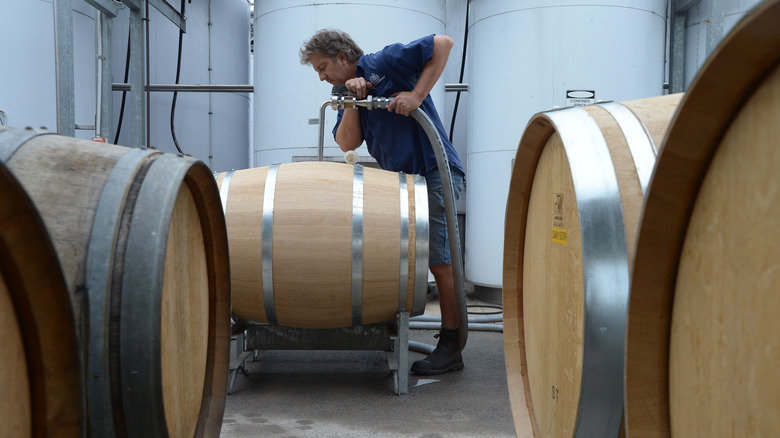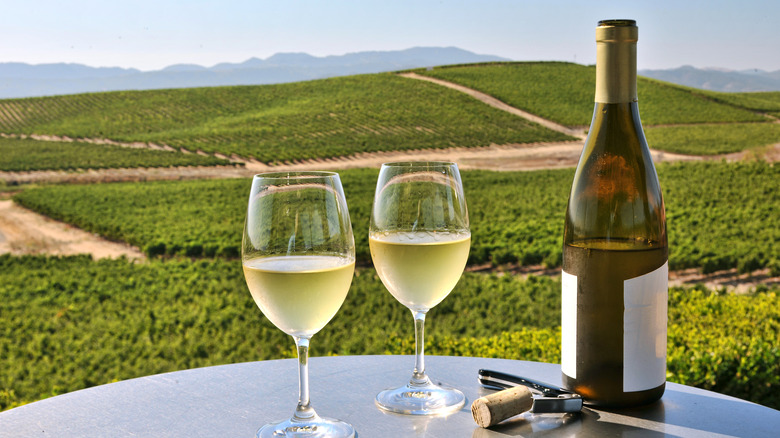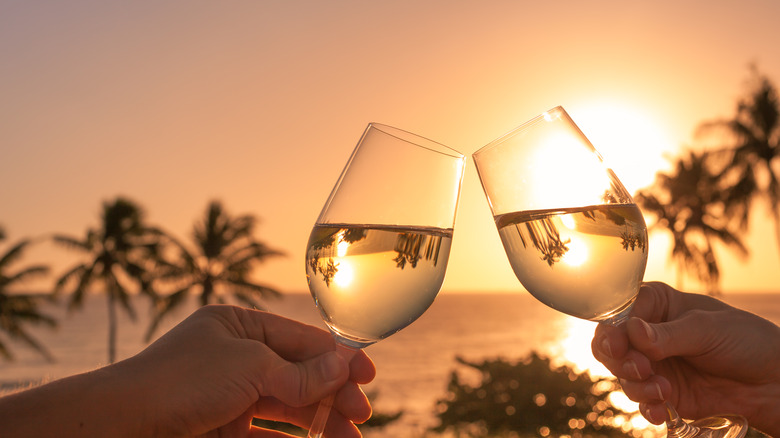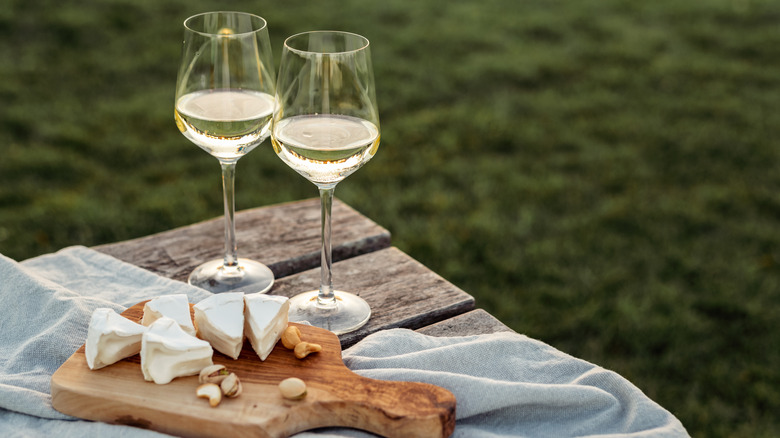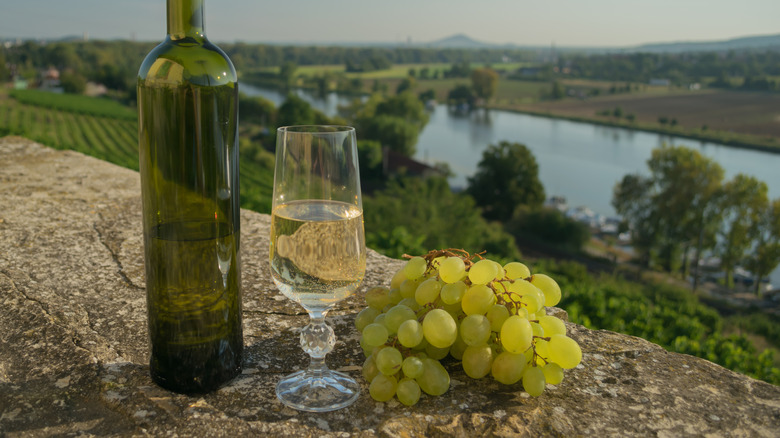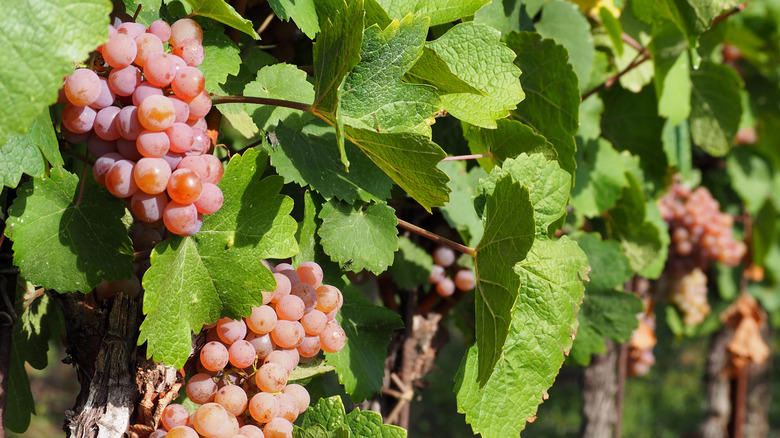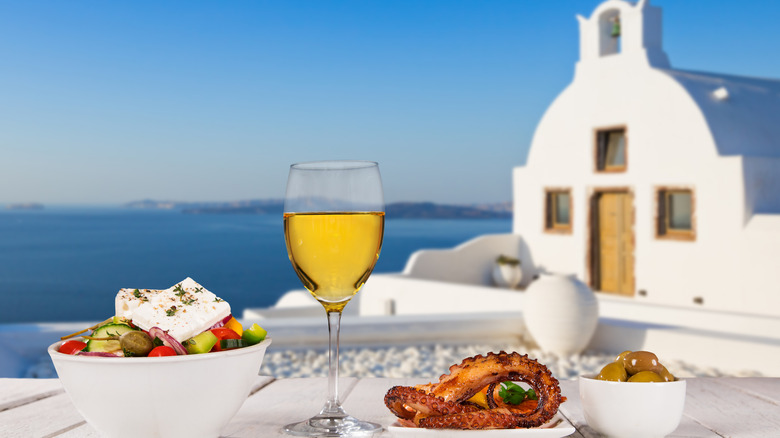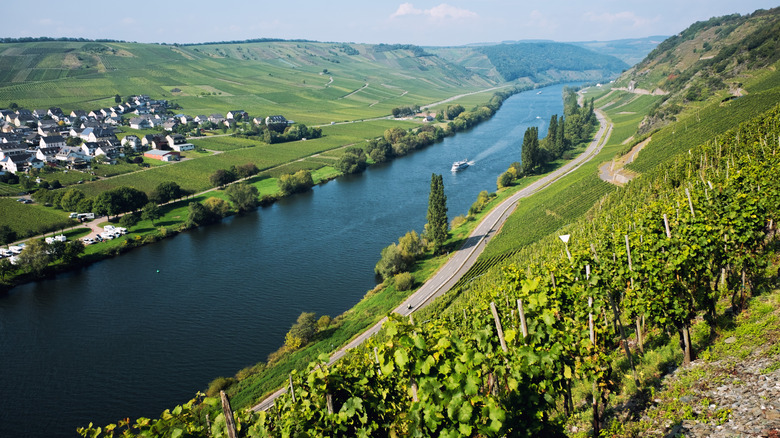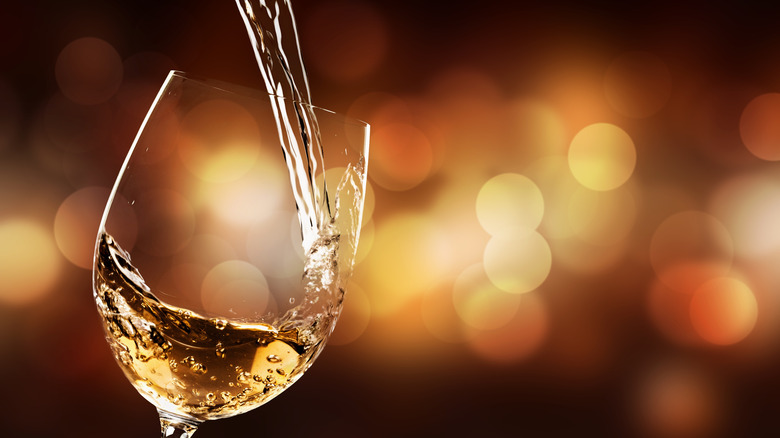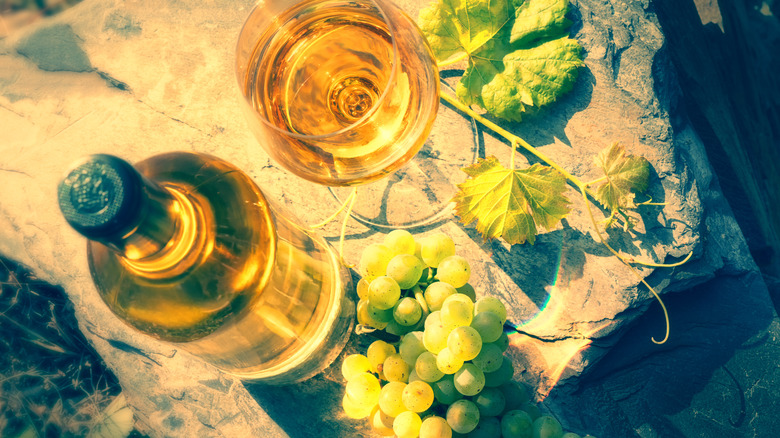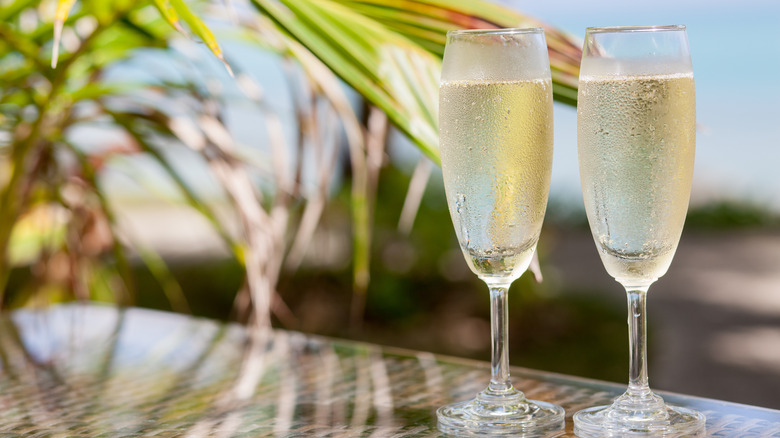What You Should Know About The Different Types Of White Wine
Red or white? Most wine drinkers ponder this question every time they buy or open a bottle. While the average person may be open to variety, some consider themselves purely red or purely white wine drinkers. Aside from the different colors, a survey by Coravin found personality differences between the two categories of consumers (via Food & Wine). Among numerous factors, more red wine drinkers identified themselves as aficionados and were able to respond to wine knowledge-based questions with greater accuracy.
Nevertheless, there's no reason to shun white wine as an inferior choice. White wine dates back thousands of years, when it was praised for its medicinal properties, according to GuildSomm. It was just as highly regarded as red wine during this time, as attested by a 2006 publication in the Journal of Archaeological Science that found remains of white wine in Tutankhamun's tomb.
Wine critic and writer Jancis Robinson explains that white grape varieties are actually genetic mutations of red grapes, lacking compounds called anthocyanins that contribute color. While the grapes may have the same origins, white and red wine have significant differences in process, flavor profile, and even the occasion for which they're best enjoyed.
The Wall Street Journal remarks that women tend to be bigger white wine drinkers for a range of reasons. The results of a 2018 study published in Food Quality and Preference also found that women more often reported joy drinking white wine. So, whether you are a woman, a pharaoh, or land somewhere in between, white wine is for everyone.
How is white wine made?
The most obvious distinction between red and white wine is of course the color, which comes down to the production. White wine grapes (which are actually usually green) are generally picked earlier than red varieties, according to Wine Folly. The source explains that winemakers choose harvest dates based on ripeness, which indicates the amount of sugar. To maintain the freshness of white wine, grapes are best picked early in the day to avoid the heat.
Next, grapes are sent straight to the winery where they are pressed to release the juices and separate the skins (thankfully this isn't done by hand!). Wine Folly notes that any sediment in the juice is removed to leave only the clear juice for fermentation. Wines.com further explains that fermentation is usually longer for white wines than for red wines since the temperature must remain cool, slowing down the yeast activity.
Once the juice becomes fermented (aka has alcohol content), it spends some time maturing prior to bottling. Stylistic differences can be made at this point that may alter flavor and texture, such as by aging the wine in oak barrels or in simple stainless steel tanks, as per Wine Enthusiast. When the winemaker is satisfied with the level of maturation, Wine Folly notes that wines can be blended before clarification. The source explains that clarifying wines is done to filter out any sediment, protein, and yeast that might result in spoilage. Finally, wines are bottled, increasingly with screw caps since many are meant for immediate consumption.
Why malolactic fermentation is important for white wines
As mentioned, some notable differences occur in flavor profiles by aging white wine in oak barrels. Aside from the influence of the barrel itself, Wine Folly explains that malolactic fermentation is a common occurence. While it is often referred to as a "secondary fermentation," Wine Enthusiast reports that bacteria, not yeast in this case, is responsible. The bacteria in question, Oenoccocus Oeni, converts malic acid (found in green apples) into lactic acid, according to Wine Folly. Due to the characteristics of the lactic acid, a sharper, high acid wine becomes more soft and creamy, often with added buttery flavors.
Decanter points out that some winemakers choose to introduce the bacteria to produce the outcome, but it can also occur naturally. Not all wines benefit from malolactic fermentation, and sometimes only a portion of a wine undergoes it. Likewise, wines with a zesty crisp freshness are not good candidates for the process.
If you're wondering whether malolactic fermentation might be responsible for the flavors in the creamy, buttery Chardonnay you've had, chances are it is. Rich, velvety wines including Chardonnay and Viognier often undergo a secondary fermentation to bring out their rounded characteristics. While you may have previously associated the flavors with oak (they often go hand in hand), keep in mind that buttery aromas indicate this extra fermentation. Some bottle labels will specify whether or not the reaction has occurred, but once you tune your palate to the flavors, you might start noticing it yourself.
Chardonnay
As the most widely planted white grape in the world, according to Wine Folly, Chardonnay has quite the reputation. Originally from Burgundy, France, Chardonnay is now planted around the world, notably in California, Australia, New Zealand, Chile, and South Africa (via Roberson Wine).
While there tends to be a significant divide between people who love or hate Chardonnay, thanks to its incredible adaptability in the vineyard and in the winery, a large range of styles are possible. When aged in oak barrels, you'll get a fuller body wine with vanilla and spice flavor, whereas when aged in stainless steel tanks Chardonnay is a crisp, refreshing wine, explains Thrillist. Chardonnay is also a popular candidate for malolactic fermentation, which explains the buttery creamy aromas you might taste in your glass.
Climate plays a considerable role in flavor as well, with citrus and apple flavors popping up from those varietals grown in cooler regions, and tropical fruits more noticeable with heat (via Lazenne). If that wasn't enough selection, Chardonnay grapes are regularly used to make sparkling wine, including Champagne, the most prestigious of the lot.
Being such a versatile wine, Chardonnay can be paired with a variety of dishes. For lighter styles, opt for similarly light preparations such as seafood and mushroom-based dishes. If you've chosen a richer style wine, think of pairing it with a creamy dish or a heavier seafood preparation such as a buttery lobster.
If you like Chardonnay try...
If you enjoy the versatility of Chardonnay, and are looking for another chameleon grape, Chenin Blanc is a good bet. Wine Country explains that these wines can be crisp and dry with a mouthwatering acidity, or outright sweet with fruity floral flavors, and they even come in a range of sparkling styles.
For another full-bodied wine with intense flavors, Viognier is a good choice. Denver Post describes it as creamy and soft, with aromas of tree fruits. Much like Chardonnay, it can be aged in oak barrels and often undergoes malolactic fermentation to expand on the rich flavors. The source remarks that Marsanne Roussanne blends, which often go hand-in-hand with Viognier in France's Rhone Valley, are a nice alternative for Chardonnay lovers.
For a unique flavorful wine, seek out Fiano di Avellino from Southern Italy. The Chicago Tribune describes it as having nutty mineral aromas balanced by stone fruits. It may not be the easiest wine to find but, if you come across it, be sure to snag a bottle. Viura or Macabeo from Spain is most famously known as one of the grapes blended in Cava sparkling wine, but it is also used to make white wines in Rioja, with aromas of lemon, melon, and herbs (via Dcanter).
Sauvignon Blanc
Sauvignon Blanc is considered one of the more recognizable grapes thanks to its intense aromas. Lazenne describes flavors of citrus, passion fruit, gooseberry, grass, and minerals, in varying degrees depending on the source. If you're less of a fan, or come across a mediocre example of the wine, Wine Folly remarks that aromas of cat pee are not unheard of, so it's good to be choosey!
Sauvignon Blanc is actually a parent to the bold red grape Cabernet Sauvignon. Aside from genes, Wine Folly indicates that the two share a compound which produces flavors found in green peppers. The grape is grown in France, namely Sancerre and Pouilly-Fumé, two locations considered to be benchmark styles, as noted by Roberson Wine. The site explains that the French style is less fruity and displays more mineral flavors. Across the globe, Lazenne notes that New Zealand really brought the grape to the spotlight, and the region's cool climate has proven to be an ideal match. The grape can be found worldwide though, including in Chile, Australia, South Africa, and California.
This type of vino has a good amount of acidity and tartness, which makes for an easy match with food. Try it with herbaceous dishes such as Thai and Vietnamese cuisine, green vegetables, charcuterie, and seafood. As for cheese, Lazenne notes the herbal flavors in the wine are a classic pairing with goat cheese.
If you like Sauvignon Blanc try...
If you're a Sauvignon Blanc devotee, chances are you love bold aromas and fruity herbal flavors. And if so, you're in luck because plenty of white wine grapes express a similar range of aromatics. Denver Post recommends trying an Argentinian Torrontés, brimming with floral fruity notes. While the wine may evoke sweet flavors, it is crisp, dry, and wonderfully refreshing. If you enjoy the zestiness of Sauvignon Blanc, Albariño from Spain is your new best friend. Teeming with citrus, stone fruits, and tropical aromas, this Spanish wine is the perfect accompaniment for seafood or herb-heavy dishes (via Wine Folly).
If you're a fan of the herbal aromas of Sauvignon Blanc, go for an Austrian Grüner Veltliner — with it, you'll likely taste some peppery flavors as well. Likewise, Wines 'Til Sold Out recommends trying Verdicchio from Italy for a crisp citrusy wine that pairs delightfully with seafood. Another Italian grape that might satisfy your desire for a crisp citrusy wine is Vernaccia. One of very few white grapes from Tuscany, this wine has aromas of apples and pears, with an underlying note of almonds (per Dcanter). If you're stuck on Italian wines, Dcanter also recommends trying Friulano, a highly acidic and floral variety with an element of salinity. The grape is also called Sauvignon Vert, and until recently, many of the plantings in Chile were mistaken for Sauvignon Blanc, says Wine Searcher.
Pinot Gris
Unfortunately for Pinot Gris, the high yields of these grapes means that plenty of flavorless bottles abound, according to Lazenne. Nevertheless, Decanter attests that the grape has excellent potential when grown judiciously, confirmed by finer examples in Northern Italy and Eastern France.
Pinot Gris and Pinot Grigio are in fact the same grape, in French and Italian, respectively. Decanter explains that, language aside, the names hint at the style of wine. The source notes that Pinot Grigio from Italy is crisp with citrus and stone fruits. Meanwhile, the French style, mainly produced in Alsace, is richer with spice notes and can be slightly sweet. Some Alsatian Pinot Gris varieties are fully sweet, produced from late harvest grapes. Elsewhere in the world, both styles are produced, namely in Oregon, New Zealand, British Columbia, and Germany.
Unlike most white wine grapes, Pinot Gris stands out due to its pinkish skin. The grape is actually a mutation of Pinot Noir, which explains the hue. Thanks to the color of the skins, rosé can also be made from Pinot Gris. In fact, traditionally in Northern Italy, Pinot Grigio was made in the ramato style using grape skins to produce a copper-tinged wine (via Decanter). As with most trends, the old becomes new again and many present-day winemakers have hopped onboard, making what is commonly called orange wine.
Wine Folly suggests pairing crisper styles with light dishes and seafood, and richer Alsatian styles with pork or spicier dishes.
If you like Pinot Gris try...
Depending on the style of Pinot you're into, there's a range of wines to explore. For the lighter, crisper styles, Wine Folly recommends trying Spanish Albariño, Pinot Blanc, or Silvaner, found in France and Germany, respectively. These wines balance stone fruit and herbal flavors in every refreshing sip.
Likewise, Muscadet and Picpoul from France's Loire Valley are both fresh wines with citrus and mineral flavors. Greece's Assyrtiko grape is another perfect option if you like your white wine to be crisp and refreshing. Mainly grown on the island of Santorini, you'll notice aromas of the sea wafting from your glass.
For the softer, sweeter styles of Pinot Gris, Dcanter suggests Moschofilero, another Greek grape that produces a spicy floral wine. Other varietals with more aromatic flavors to try out include Grenache Blanc, common in Southern France or Spain, and Falanghina, one of Southern Italy's ancient grapes.
Riesling
Many people equate Riesling with an overwhelmingly sweet wine, but in reality it's far more versatile than that. Wine Folly indicates that it ranges from very dry to intensely sweet, and is regularly used to make ice wine or sparkling wine. The grape comes from Germany where it is undoubtedly a star, and also thrives in other cool climate wine regions such as Austria, Alsace, Niagara in Canada, New Zealand, and New York's Finger Lakes region (via Lazenne). Vineyards at a higher altitude in Australia are also showing off some fine examples of the grape, according to Roberson Wine.
Thankfully, Riesling has a high level of acidity that balances out the sweetness and makes it very refreshing. As well, Lazenne remarks that this acidity preserves Riesling, making it one of few white wines that can easily age for decades. Roberson Wine describes flavors of lime, peach, apricot, apples, flowers, and stones. Some varietals have noticeable aromas of petroleum — don't worry it's usually well-balanced and adds a unique touch.
Off dry and sweet Rieslings make a great pairing for spicy Indian, Vietnamese, or Thai dishes. Dry, crisp, refreshing wines are a definite match for chicken and fish, creamy sauces, and even pork.
If you like Riesling try...
Riesling is filled with bold flavors and aromatics, so you're sure to enjoy a similar profile. Try Gewürztraminer, a floral spicy wine that often brings rose petals and Turkish Delight to mind (via Wine Folly). Other grapes high on the aromatic scale are Torrontés from Argentina, or Malvasia Bianca from Italy.
If you're a fan of the range of possibilities that Riesling offers, seek out the Chenin Blanc grape from Vouvray, France. Here, you can expect anything from a dry to sweet wine, including excellent sparklers. For a rich option that is similarly bold-flavored yet fuller-bodied and mostly dry, Bright Cellars recommends picking out a wine made from Viognier.
Muscat
As one of the oldest grapes around, and possibly an ancestor to many current-day grapes, there's plenty to love about Muscat or Moscato if you're familiar with Italian versions. If your past experience of Muscat involved sweet, slightly fizzy Moscato d'Asti, you should know that many other styles exist. Thanks to its adaptability in the cellar, Wine Folly explains that Muscat can be made into dry, sweet, sparkling, and even fortified wines.
Lazenne remarks that Muscat originated in the Mediterranean, beloved by the Greeks and later brought to France by the Romans, according to Jancis Robinson. Muscat can be found all over, notably in Italy, France, Spain, and Australia (via Wine Traveler).
Robinson notes that Muscat has multiple mutations that make up a family of varieties, the noblest being Muscat Blanc. She remarks that unlike many wine grapes, Muscat actually tastes and smells like grapes. The grape is very aromatic and perfumed, even bordering on musky as per its name. Wine Folly notes strong flavors of orange blossoms, flowers, lemons, and pears.
Sweeter versions are a great match with dessert, and off dry Muscats can be an excellent palate cleanser for spicier dishes, Asian cuisine, sushi, cheese, and nuts.
If you like Muscat try...
If you like Moscato but want to branch out, go for other wines with floral aromas or off dry styles. Bright Cellars recommends sipping on Gewürztraminer, spicy with notes of rose, and an equally great match for Asian cuisine. For another style of sparkling wine that is light and fresh, consider pouring a glass of Prosecco, which tops the charts for the largest volume of bubbly sold worldwide, according to Forbes.
If you're all about the sweeter styles of Muscat, Your Glass or Mine suggests you get your hands on Sauternes, a high-quality dessert wine from France with luscious flavors of peaches and apricots. When it comes to intensely flavored, sweet, aromatic wines, we can't forget ice wine and its deeply concentrated taste, too.

